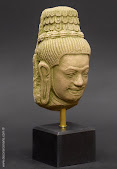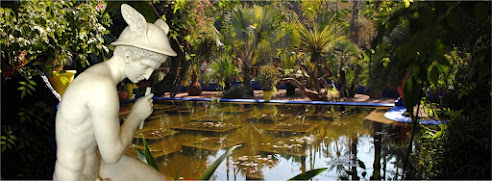One of the most recent additions to our catalog is this
reproduction of a
Buddha head, inspired by the
statues found in the temples of
Angkor in Cambodia.
In Khmer art from Angkor, there is an abundance of
sculptures depicting divine beings from both Hindu and Buddhist religions.
Among them, the images of
Buddha stand out, often depicted with a serene and
smiling face.
This Buddha head exhibits the typical characteristics of
Khmer human representations in art: a smiling face, almond-shaped eyes,
well-defined eyebrows often merging into one, and lips with outlined outer
edges.
These representations can be found as standalone sculptures, as reliefs
on temple walls, or integrated into the architecture itself, placed above
lintels or serving as column capitals.
Angkor was the capital of the Cambodian Khmer Empire (9th to
15th centuries AD), which reached its peak during the 12th century. Its
dominion extended from Cambodia, encompassing territories in present-day
Thailand, Vietnam, Laos, Malaysia, and Myanmar (Burma). After the decline of
Angkor, the vast cities and monastic complexes were abandoned and reclaimed by
the jungle until their restoration began in the 20th century by archaeologists,
turning it into a major tourist destination in recent decades. Until then, the
rest of the constructions had been at the mercy of the elements, with the
exception of the
Angkor Wat temple, which has been preserved and maintained for
centuries by the Buddhist monks who continue to inhabit it today. The image of
the ancient stone temples emerging from the Cambodian jungle, with their walls
covered in tree roots, is highly evocative and has served as inspiration for
numerous television series, movies, and video games.
This vast group of monumental cities was built during the
reigns of the Khmer dynasty monarchs, with its zenith in the 11th and 12th
centuries. Some of these complexes housed temples dedicated to Hindu deities,
while others were built as Buddhist sanctuaries. Notably, the
Banteay Kdei
complex, known as the "Citadel of Monastic Cells," dates back to the
reign of Jayavarman VII in the second half of the 12th century and was used as
a Buddhist monastery.
Buddhism reached the Khmer Empire around the 8th century AD,
coexisting with Hinduism in Angkor. In Banteay Kdei and other enclosures, you
can admire numerous statues of
Buddha and other secondary deities, genies, and
demons from the Buddhist religion. Born in India in the 5th century BC from the
teachings of Siddharta Gautama Buddha, Buddhism spread throughout Asia,
reaching Afghanistan in the west and expanding to Southeast Asian countries
like Thailand, Myanmar, Indonesia, and Cambodia, as well as reaching the Far
East, from China to Korea and Japan.
 |
Cambogia, buddha protetto dai naga,
da preah khan, stile di angkor vat, 1100-1175
by sailko under CC BY-SA 3.0 DEED |
The characteristics of art in the various countries where
Buddhism was established influenced the representations of Buddha, adapting to
the stylistic forms of each culture.
In Buddhist art, Buddha is depicted in various forms, often
with a serene and smiling face, expressing ultimate happiness and the peace of
final liberation. He can be shown in different postures: sometimes standing,
other times sitting cross-legged in the lotus position, or lying on his side.
The hand positions, or mudras, are also symbolic gestures, each with its own
meaning. He usually has his hair tied up in a bun on his head and, in some
cases, features symbolic traits like elongated ears, a symbol of Wisdom, which
can be observed in this reproduction.
A sculpture like this Buddha head can inspire us to find a
moment of calm and meditation amidst the hustle and bustle of daily life.
Placed in a special room, office, or library, it adds a special touch and
brings peace and serenity to the environment. Its presence evokes memories of
distant lands, strolls through jungle-covered temples, enveloping us in an
atmosphere of adventure and exoticism, spirituality, and mystery.
You can find this Buddha statue in our online store:
For more reproductions of Buddha, please visit this link in
our store:











Comments
Post a Comment